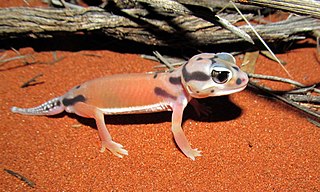
The knob-tailed geckos or knob-tails, are a group of species of geckos, all found in the genus Nephrurus.

Pierre André Latreille was a French zoologist, specialising in arthropods. Having trained as a Roman Catholic priest before the French Revolution, Latreille was imprisoned, and only regained his freedom after recognising a rare beetle species he found in the prison, Necrobia ruficollis.

Jean-Baptiste Geneviève Marcellin Bory de Saint-Vincent was a French naturalist, officer and politician. He was born on 6 July 1778 in Agen (Lot-et-Garonne) and died on 22 December 1846 in Paris. Biologist and geographer, he was particularly interested in volcanology, systematics and botany. The standard author abbreviation Bory is used to indicate this person as the author when citing a botanical name.

Oscillatoria is a genus of filamentous cyanobacterium which is often found in freshwater environments, such as hot springs, and appears blue-green. Its name refers to the oscillating motion of its filaments as they slide against each other to position the colony facing a light source. Oscillatoria reproduces by fragmentation, facilitated by dead cells which separate a filament into separate sections, or hormogonia, which then grow. Oscillatoria uses photosynthesis to survive and reproduce. Each filament of oscillatoria consists of trichome which is made up of rows of cells. The tip of the trichome oscillates like a pendulum. In reproduction, it takes place by vegetative means only. Usually the filament breaks into a number of fragments called hormogonia. Each hormogonium consist of one or more cells and grow into a filament by cell division in one direction.

Audouinella, also known as black algae, is a widespread genus of red algae, found in marine and freshwater environments.

Brongniartella is a genus of red alga, named after French naturalist Adolphe Brongniart.
Pierre Auguste Joseph Drapiez was a Belgian naturalist. The standard author abbreviation Drapiez is used to indicate this person as the author when citing a botanical name.

Amoeba is a genus of single-celled amoeboids in the family Amoebidae. The type species of the genus is Amoeba proteus, a common freshwater organism, widely studied in classrooms and laboratories.

Michel Charles Durieu de Maisonneuve was a French soldier and botanist who was a native of Saint-Eutrope-de-Born in the department of Lot-et-Garonne.

Halymenia a genus of a macroscopic red algae that grows in oceans worldwide. It includes the following species:

Jean Vincent Félix Lamouroux was a French biologist and naturalist, noted for his seminal work with algae.
Jean-Pierre Sylvestre de Grateloup was a French physician and naturalist.

Brama is a genus of marine ray-finned fishes from the family Bramidae, the pomfrets. Currently, there are 8 species within the genus.

Achnanthes is a genus of diatoms belonging to the family Achnanthaceae.
Testudinella is a genus of rotifers belonging to the family Testudinellidae.

Eulalia aurea is a grass. It was first described as Andropogon aureum in 1804 by Bory de Saint-Vincent but was transferred to the genus, Eulalia, in 1830 by Kunth.
Diatoma is a genus of diatoms belonging to the family Fragilariaceae.
Brachionidae is a family of rotifers belonging to the order Ploima.
Fucophycidae is a subclass of Phaeophyceae which contains the most complex and evolved orders of Chromista algae. The members of this subclass have stalks with several morphological forms and distinct structures, characterized by an intercalary growth and a basic heteromorphic, sometimes secondarily iso- or sub-isomorphic life cycle.
Taxonomy













